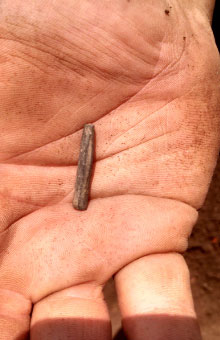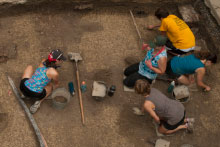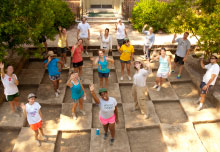
Bray School Excavation
Uncovering Evidence of an 18th-Century School
Named for English philanthropist Reverend Thomas Bray, Williamsburg's Bray School was established in 1760 "for the instruction of Negro Children in the Principles of the Christian religion." Between 2012 and 2014 Colonial Williamsburg archaeologists, in conjunction with faculty from the College of William and Mary, conducted an archaeological field school on the institution's first site.
Education for Black Children
Williamsburg's Bray School operated for 14 years. Black children—male and female, enslaved and free—learned Anglican catechism in addition to skills such as reading, writing, and possibly sewing. The school closed in 1774 at the death of its schoolmistress, Ann Wager.
For the first five years of the the Bray School's operation, Ann Wager taught classes in a rented house. The building stood near the corner of present-day Prince George and Boundary Streets. Today, William and Mary's Brown Hall occupies the site.


Archaeological Discoveries
Recent archaeological investigations focused on finding the architectural footprint of the Bray schoolhouse, as well as evidence of the lives, daily routine, and studies of its students.
After three summers of excavation, archaeologists have concluded that architectural remains of the school were largely destroyed by the 1930 construction of Brown Hall. Partial foundations of two 18th-century outbuildings—likely a kitchen and a dairy or smokehouse—were discovered beneath the rear wall of the modern dormitory. As these service buildings probably stood behind the schoolhouse, their presence argues strongly that it once stood where Brown Hall does today.
Archaeologists recovered approximately 50 slate pencil fragments from the dig—more than have been recovered from any other site in Williamsburg to date. Their presence is significant. It hints that, besides practical skills and Biblical recitation, instruction at the Bray School may have included writing.
Tens of thousands of artifacts—ceramic and glass fragments, animal bones, oyster shells, and small finds such as clay marbles and doll parts—are now being washed and analyzed. They will undoubtedly add depth and detail to the story of the Bray School and its students.
The Rest of the Story
The Bray School's short tenure represents just one chapter in a centuries-long site history. In addition to the 18th-century outbuildings mentioned above, archaeologists and field school students uncovered a 17th-century subfloor pit. The pit provided storage for a building no longer in evidence, and was abandoned early in the 18th century.
A late 18th-century well, found in front of Brown Hall, likely served residents of the property after the Bray School moved to a new location. The well remained in use through the early 20th century.
Finally, a 16′-by-6′ earthfast (post-in-ground) building with a subfloor storage pit and a related 8′-by-8′ earthfast storage building were uncovered behind Brown Hall in 2012 and 2013. The larger building is being examined as a possible "quarter" for the enslaved. Further research will help place all of these features in their correct historical and spatial contexts.
